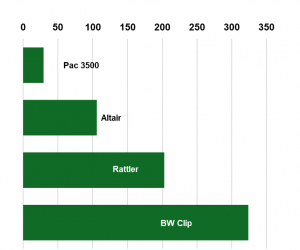Press release: Study finds that routine care of low cost hydrogen sulfide monitors is needed to save lives.
Date: November 21, 2017
Link to article: Evaluation of low cost hydrogen sulfide monitors for use in agricultural production.
Last fall, livestock producers in Iowa, Illinois, and Wisconsin were alerted to the dangers of hydrogen sulfide gas following a series of cattle fatality incidents during manure handling activities. Hydrogen sulfide is an important manure pit gas, and it is released during agitation and manure pumping. Many livestock workers are familiar with the gas’s “rotten egg” odor.
Some producers are starting to wear low cost direct readying gas monitors to provide warning alarms when hydrogen sulfide gases are released and become dangerous to life and health. Hydrogen sulfide monitors are available from many manufacturers and are recommended for use during manure handling operations. Leaving the area when a gas monitor alarms can save lives.

The number of days until a first failure of personal hydrogen sulfide monitors stored in livestock buildings.
Researchers at the University of Iowa compared the performance of four easy to use, low-cost hydrogen sulfide monitors in an article published in the Journal of Agricultural Safety and Health. Although each gas monitor had different features, all of the monitors had a low and high alarm to alert the user of dangerous hydrogen sulfide levels. In addition, all monitors were advertised as good for at least two-years in the field. The researchers tested each monitor’s performance over time, simulating what they might be exposed to over one year of use in a livestock environment.
Performance of monitors declined over time. All of these monitors showed signs of reduced performance as the study progressed. “When we exposed these monitors hydrogen sulfide at levels that would be seen on the farm, the time it took for the monitor to signal an alarm increased,” said Dr. Renée Anthony. “This would be a problem if someone wearing the monitor was not warned of hazardous concentrations quickly.”
Not all manufacturers recommend performing bump tests on gas monitors. However, the results of this study recommend that you should. The “bump test” simply requires delivering a known concentration of gas to the monitor and then checking: Does the alarm go off? Does it alarm quickly (<15 seconds)? If the monitor displays a gas level– does it match the one on your gas bottle? “Bump testing is important for workers who plan to perform high-risk activities like agitating or pumping manure and pressure washing”, said Anthony. “If your monitor doesn’t display the gas level, it is the only way to know if the sensor still able to detect hydrogen sulfide.”
- Information for how to perform a bump test is available HERE. Producers should plan ahead and test their monitors before using them in potentially hazardous situations.
- For questions on gas monitors or how to perform bump tests, please contact the Great Plains Center for Agricultural Health at CPH-GreatPlainsCenter@uiowa.edu.
